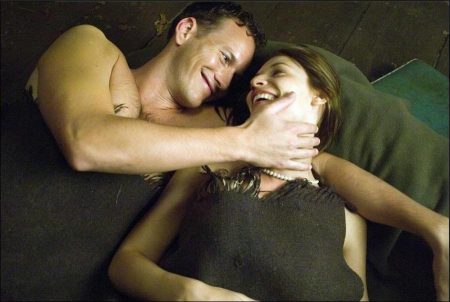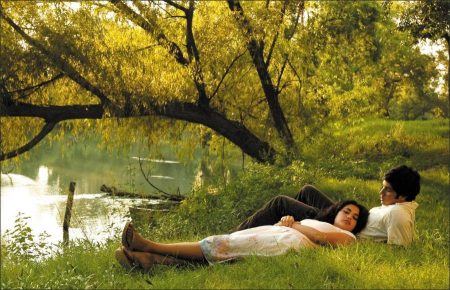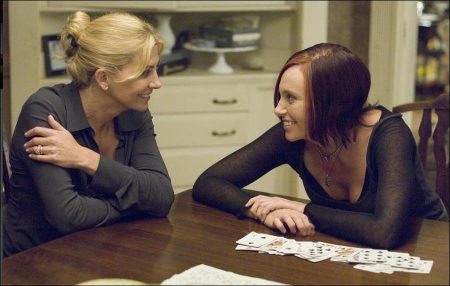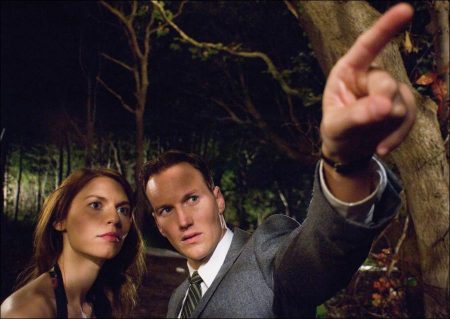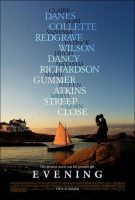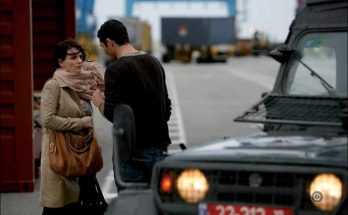Evening Movie Trailer. Budapest-born Lajos Koltai, an Academy Award-nominated cinematographer, had recently made his feature directorial debut with the uniquely realized Holocaust story Fateless. Sharp notes, “We were looking at directors across the whole filmmaking spectrum. At the urging of a Focus executive, Michael and I went to Manhattan’s Film Forum movie theater one afternoon to see Fateless.
“From the opening scenes, we realized that we were in the hands of a master filmmaker – a virtuoso. He gets inside his characters and has a deep understanding of the human condition, and how we all aspire to something better; even if we don’t attain it, there is that basic human desire to try. That was evident in Fateless, and needed to be in Evening as well. Coupling that with his sophisticated eye and sense of film as a visual medium, we thought he would bring the right sensibility to this material. So we went back to Focus and said, ‘This is our guy.’ We then got the script to Lajos, and he responded immediately.”
The director was drawn not only to the prospect of making his first English-language feature but also to the story’s universal themes. Koltai says, “What a gift it was to read this script. It addresses what is important to all of us; the desire for security, the search for someone to love, and how the decisions we make carry through the rest of our lives and our children’s lives. As our children make their own way in the world, will they know the moments that defined us? And will they learn from what we did or didn’t do?
“In the 1950s, Ann Grant has her moment. It’s something that she keeps with her always, though her perspective on it has changed over the course of her life and changes for good during the course of the story, as it applies to her daughters.”
Sharp comments, “It didn’t surprise us to find that Claire was Lajos’ first choice for the lead role – and he had worked with her before, as a cinematographer [on Home for the Holidays]; she was made for it, or it was made for her. Similarly, Lajos’ first choice was to play Ann Lord was Vanessa Redgrave. While the character may be in bed for almost all of her screen time, with Lajos directing Vanessa we knew that Ann Lord would still come across as dynamic. Luckily, she too had just seen and loved Fateless, so Lajos and I flew to London to meet with her. Within seconds, it was as if they had known one another for years. It became a done deal over a cup of tea.
“The casting process on Evening was the most exciting experience of my career. There were a number of wonderful roles, especially for actresses, but all the parts had been scripted with great detail and love.”
Cunningham adds, “While working on a screenplay, I develop a clear idea of the characters, so I don’t think about particular actors. But I will say that as the screenwriting on this movie progressed, for Ann Grant, I did start thinking about Claire Danes – whom I’ve known for years and who has, in abundance, Ann Grant’s intelligence and spark, her rebellious spirit. I was thrilled when Claire agreed to do it.”
Danes elaborates, “Both the novel and the script are fantastic. I took advantage of having the novel, as a rich resource. But the adaptation reinterprets it wonderfully for the film medium. It has its own freshness and urgency. I feel that the film considers the question, ‘What makes a life?’ We are all human and searching throughout our lives.
“My character is having defining experiences and starting to make life choices. It’s always exciting to play somebody undergoing a transformation, and when she goes to the Wittenborns’ it’s a seminal weekend for Ann. By the standards of the high-society world that she is visiting, she is a little unconventional. She is very idealistic and ambitious – not in a cynical way, but in terms of what she expects out of life. She is already negotiating her desires to be independent and her desires to have a family. She is drawn to motherhood, but also to performing. So the Ann Grant whom I play is quite different than the Ann Lord whom Vanessa plays.”
Danes and Redgrave met up during rehearsals where, Danes laughs, “With a legend like Vanessa, I talked about nearly everything but how to approach playing the same character! We decided that, while Vanessa’s Ann is not really ‘herself’ anyway in her scenes, it wasn’t necessary to be too similar.
“But we did talk about ways to create some consistency. Vanessa listened closely to me speak, and to a taped interview I had done with a dialect coach, because – being English and playing an American – she thought it would be best.”
The mother/daughter themes so prevalent in the story soon informed the casting process as well. Redgrave, like Ann, is a mother of two daughters. Her older daughter, Natasha Richardson was paged for the role of Constance, Ann’s older daughter. While Redgrave and Richardson had appeared together in The White Countess two years earlier, Evening afforded the two actresses the chance to play opposite each other as mother and daughter for the first time on-screen. Sharp remarks, “I’d always wanted to work with Natasha. I think the opportunity to work with her mother and play out such a personal drama between the characters of this mother and daughter was enormously appealing to Natasha – who brought us some terrific ideas to better flesh out Constance.”
Richardson reveals, “My mother and I told Lajos, ‘This is the only time we’ll ever get to play mother and daughter on film, and we want to take advantage of that.’ So Michael wrote a very beautiful scene into the script just for us. It was a joy to be in a story with this subject matter, where we could utilize so much of our own relationship and our own history, bringing it all to the table. Also, I was thrilled to be working with her; who wouldn’t be? Even if I weren’t her daughter – she’s Vanessa Redgrave.
“In the film, I play the ‘good daughter’ who has herself together, in a stable home and family life. My character, Constance, has a very sisterly relationship with her younger sibling Nina – although sometimes they’re at each other’s throats. Constance and Nina don’t always see things the same, but they share enormous amounts of love and warmth, like so many sisters.”
Cunningham remarks, “There is a scene between Constance and Nina that was quite challenging to script in a way that was true and moving. They have the sort of fight that was very familiar to me from what I went through with my own family when my mother was dying. During a crisis like that, you sometimes find yourself lashing out at the very people who are most important to you.”
Drawn, like everyone else, by the universality of the story and the themes, another mother/daughter acting duo would soon come aboard Evening. Sharp notes, “Mamie Gummer came in to audition for the role of [bride-to-be] Lila Wittenborn, and really got to the core of the character.”
Gummer elaborates, “Lila comes from blue-blood privilege, but feels trapped by it. She would give it all up in a heartbeat if the man she is truly in love with – which is not the man she’s set to marry – would have her. I was drawn to her sadness, and to the story’s exploration of the conflict between love and societal compromise, which is as old as time.
“Ann Grant and Lila don’t have a whole lot in common, yet they are best friends with unconditional love for each other. They were drawn to each other in college, and they formed a sisterly bond. Off-camera, Claire and I perfected that friendship.”
Danes offers, “I really loved playing scenes with Mamie; it’s not often that I have the opportunity to play out a female friendship of true intimacy on-screen. She is a gifted and beautiful actress, and we are now great friends ourselves.”
Sharp reveals, “Mamie had blown us all away in one audition, and then again in another that we scheduled because she was so great the first time. Lajos immediately wanted her to play Lila Wittenborn; it was only afterwards that we told him that Mamie is related to an actress named Meryl Streep.
“Credit for the idea of Meryl of appearing as Lila Ross [the later-in-life Lila Wittenborn] belongs to our costume designer Ann Roth and our hair and makeup designer J. Roy Helland, both of whom have worked with Meryl for years and years. Ann gave the script to Roy, who was in Central Park rehearsing Mother Courage with Meryl. Roy just happened to leave a copy on her dressing-room table. She read the script, loved it, and thought it would be fun to be in the movie. Mamie said that she was really happy that she could help her mother find a job.”
Danes adds, “Mamie and I were able to watch dailies of a scene that Meryl and Vanessa have together, so that we could echo it in a parallel scene we have together. We were thrilled watching it, but also thought, ‘We’re supposed to match that…?’ But our scene – on the morning of Lila’s wedding – was just so well-written; there are three distinct chapters within it.”
Gummer concurs, “It was all there on the page; it’s my favorite scene in the film, and so moving. “My Mom and I had joked about maybe giving Lila a limp for continuity, but we didn’t follow through on that. So Claire and I watched the dailies of the other scene – which was staggering – the night before we shot ours, and tried to sort of emulate that.
Koltai had a specific actress in mind to portray Lila’s on-screen mother. Sharp comments, “Lajos had worked with Glenn Close before, as a cinematographer [on Meeting Venus], and they had enjoyed a real rapport. So she was the first person he thought of to play Mrs. Wittenborn; he knew that she could embody the character’s matriarchal persona while also imbuing it with humanity.”
Close states, “Lajos and I have stayed friends, but – you get a well-written story like this with wonderfully complex characters being played by extraordinary actors like Vanessa Redgrave, and you really want to be a part of it. I always find it very moving to see characters when they are younger, full of hope for what their life is going to be, and then looking back. Evening is about family, and how the choices of one generation affect the next generations.
“I like Mrs. Wittenborn; she is so much like a lot of the women I remember from growing up in Connecticut. The writing captured the air these women have. Mrs. Wittenborn always wants to be socially correct, rather than confront problems in her family. It’s the American version of ‘stiff upper lip.’”
For the role of Ann’s younger daughter Nina, Sharp immediately thought of Toni Collette, who had recently starred for him in The Night Listener. Sharp laughs, “Given the creepy intensity of her role in that movie, I had later promised Toni that I would give her a part that was actually something that she could enjoy playing more. So I told her, ‘I’ve got that great part for you; you get to be as beautiful and fabulous as you are in real life!’ Within a week of my giving her the script, she called and said she wanted to play Nina.
“Watching her interact with Vanessa and Natasha in their scenes together, I could see extra texture being added into material that was already very rich.”
Taking on one of the story’s most challenging roles – and one greatly expanded from the novel – Hugh Dancy was cast as Buddy Wittenborn. “Buddy is now at the heart of Evening,” states Sharp. “We needed an actor who could incarnate a character that every audience member will care about and relate to. Hugh recognized all that, and gets it onscreen in spades. Hugh is strikingly handsome, but he also has a real talent for getting inside a character and turning in a tremendous performance. I’ve noticed that in each of the diverse roles he’s played over the past few years, and Lajos also knew his work already. Hugh really responded to the role of Buddy, and how it was written in the script.”
Dancy says, “I was blown away reading the script; the characters’ journeys were complex, engaging, and human. We are all trying to figure our way through the puzzle of life, and get to the end intact, and it was unusual to find that in a script. “Buddy is quite charming. He deals with his family by drinking too much and by joking about everything.
Over the course of the story and the weekend, you realize that underneath what seems to be an incredibly vivacious and liberated spirit lays a mess of complications.”
Danes adds, “Ann has a longstanding deep friendship with Buddy, but she has come to feel responsible for him and worry excessively about him. When she meets Harris Arden, she realizes that he is somebody that she doesn’t have to rescue.”
Sharp says, “Given his talent, we had always thought of Patrick Wilson for Harris; however, we figured he would be unavailable. But we sent him the script and he fell in love with it. As an actor, he has a quality of timeless masculinity that enables him to fit right into the world of the 1950s that we re-create in the film.“
Wilson offers, “I fell in love with the story, like all of us did. It inspires you to savor the life and love that you have. What I found daring about the script was that there is a beautiful romantic story but it’s intercut with these wonderful scenes between a mother and her daughters. Vanessa Redgrave is such a powerful presence that I’m excited to see how Ann Lord’s journey plays out on-screen.
“As an actor, I liked that I would have plenty to play, because a lot happens among Harris, Ann Grant, Lila, and Buddy. It’s a little messy – like life really is.”
To round out the cast, the production secured the participation of another actress who had starred prior with Vanessa Redgrave; Dame Eileen Atkins plays Ann Lord’s night nurse.
Atkins offers, “My character is a caregiver who doesn’t get emotional about anything. Yet she is kindly and warm toward Ann – and when the one person you see all the time is a nurse, in your mind the nurse can become all kinds of things.
“As a director, Lajos has a wonderful way of giving you the right thing just before you do a take; he empathetically enters into it with you. As a former cinematographer, he knows how to make a picture; you can act your socks off and be wonderful, but if it doesn’t look good and look right all around you, forget it.”
Danes adds, “He has a deep sense of how people relate to each other, and is quite focused on performances because he values actors. That is not always the case with directors. But Lajos is always there by the camera, never off by a monitor. He created an absolutely secure environment for all of us to be as vulnerable and expressive as we needed to be.”
“He gives everybody encouragement and puts them at ease,” remarks Dancy. “He’s enthusiastic, and yet always precise.”
Gummer says, “You feel that he cares about everything; no detail is missed or overlooked. There is a great level of comfort with him.”
Minot reports, “Lajos does something on the set which I think is ideal; he takes actors aside and talks with them quietly, so that no one else can hear. It’s a more private and gentle interaction.”
Cunningham notes, “He’s a true artist, intelligent and intuitive. He loves actors and writers, and respects what they can do. After decades as a cinematographer, he has a sophisticated and magical visual imagination.”
Close comments, “Lajos comes from a very rich tradition of Hungarian filmmakers. Many of them cut their teeth when there wasn’t a lot of film stock, so they would have to edit in their heads more; he has precise discipline and doesn’t waste time.”
Two different worlds in two different time periods are dramatized over the course of Evening; a private vigil in the present day, and an expansive turning-point summer weekend some fifty years prior. Although the novel was set in Maine, the screenplay adaptation left the setting unspecified. Given the Wittenborns’ status, though, the filmmakers scouted the New England Coast. A Rhode Island tax incentive proved especially encouraging and Sharp remembers, “As soon as we saw Newport and drove down Ocean Drive, we sensed we were in the right place.”
Evening’s location shoot in the state of Rhode Island included extensive lensing in Tiverton, Jamestown, and Newport. Notable ones within the latter included Rose Cliff, Trinity Church, and Easton Beach. The production also shot scenes in New York City, at locations including West 12th Street in Greenwich Village and the Upper West Side.
To maximize every location and fully convey the two different worlds for Ann’s past and present, the production mined the expertise of Academy Award-winning costume designer Ann Roth (who had costumed several of the actors on previous projects), production designer Caroline Hanania (whose years of work with director Peter Chelsom had caught Sharp’s eye), and cinematographer Gyula Pados (who had previously shot Fateless for Koltai).
The latter, assures Sharp, “is at the beginning of an amazing career. He and Lajos share a singular vision for how their movies together should look.”
Close remarks, “Gyula is brilliant, and he and Lajos have a wonderful synergy. They light scenes beautifully – and, remarkably, fast!”
Wilson, who had been costumed by Roth a few years earlier for Angels in America, says that she is “the best in the business. In our costume fitting, I tried on a suit and said, ‘This fits really well, Ann.’ She said, ‘Well, it should; it’s yours from Angels in America.’
“We ended up not using it, but I loved being costumed by her again, this time for the 1950s. The era really appeals to me – and so do its clothes, high-waisted pants and all.”
The wedding party and its attendant complications progresses in and around the Wittenborns’ “summer cottage” in Newport, and the production found a house there that conveyed both grandeur and intimacy. The family home seen on-screen is a real one – built in 1865 – that is located at the end of Newport’s most historic street, “and it is absolutely perfect,” marvels Hanania. “The home stands out on a bluff, like something out of an Edward Hopper painting. It’s so appropriate for our story’s Wittenborn family.
“This is a family that takes pride in themselves, and Lajos wanted to have a lot of portraits on the house’s walls – so that they are almost reflecting themselves.”
Accordingly, the crew had several replicas made of works from painters and portraits of the ‘50s. Hanania adds, “But we were also able to use paintings by the owner’s grandfather, which were quite beautiful. That family also lent us photographs from a wedding in the ‘50s, which Ann Roth and I especially appreciated as a resource. To recreate that period, a lot of the set dressing was bought locally. There are no prop houses in that area, so we scoured the region’s consignment and antique shops. We found all sorts of wonderful things.”
The present-day home of Ann Lord is more modest, though also more cluttered. Hanania says, “We found a private residence in Tiverton that had the spirit and geography that felt right for the character, as someplace that she had lived for a long time. We transformed what is actually a sitting room into her bedroom because Lajos had a specific idea for two windows on either side of the bed, for a shot that closes the film.
“Lajos, Gyula, Ann Roth, and I made definite choices in terms of the color and design schemes for the two homes. Ann Lord’s home is a shot in a slightly monochromatic way, which gave me the opportunity to use a lot of texture. I used damask on the walls, and we used glass objects to pick up the light. The Wittenborn house is much grander and more formal, yet also lighter and brighter. The many rooms there have an optimistic feel to them, echoing the excitement of the weekend and the era and the youth of Ann, Harris, Buddy, and Lila.”
Koltai adds, “The world that Ann Lord is remembering is such a lush and desirable place to be; friends, bridesmaids, tuxedos, crowns of flowers, whiskey glasses, sunshine, salt water, and youth. At the end of her life, she suddenly flourishes in the company of these memories. Her last waking days are interlaced with her past, and she comes to terms with both, which in turn gives renewed strength to her daughters and their own relationships.”
The cast spent extra time in Rhode Island for a rehearsals period, which all concerned knew was essential for the film’s dramatic scenes and character interactions. It was during this time that the story’s themes would frequently come to the fore, and impact the creative collaboration process. Sharp remembers, “One night, a whole group of us gathered by the fire pit of their Newport hotel, and – as happens on a movie when cast and crew hang out together – started telling stories. There were plenty of amusing anecdotes going around, and then someone brought up favorite songs. Well, several people got up and took turns entertaining the others with a song or two.
“Claire got up and shared something with us – a song, but not just any song; ‘I See the Moon,’ which her mother had sung to her when Claire was a child. When Claire sang it, she took our breath away.”
Although Ann would have her career be as a singer, Danes thus far has not. She confides, “I have dance training, but not singing training. I’d never sung in a movie before Evening, and I was intimidated. But I worked with a wonderful vocal coach named Deb Lapidus, who educated me about breathing and how singing is a very physical process in which you really use your body. So my dancing definitely helped. As for the singing per se, I think I had good phrasing instincts. I was inspired enough to continue studying it.”
Sharp marvels, “A week after that night around the fire, we were already filming one of the most poignant scenes in the movie – which is also one of Claire’s most crucial ones. It’s a very intimate scene where Ann is at home with her two young daughters. We needed a song for Ann to sing to her little girls. “There was only one choice; the song that Claire’s own mother had taught her.”
Evening (2007)
Directed by: Lajos Koltai
Starring: Claire Danes, Toni Collette, Vanessa Redgrave, Patrick Wilson, Hugh Dancy, Natasha Richardson, Dame Eileen Atkins, Glenn Close, Meryl Streep, Mamie Gummer
Screenplay by: Michael Cunningham, Susan Minot
Production Design by: Caroline Hanania
Cinematography by: Gyula Pados
Film Editing by: Allyson C. Johnson
Costume Design by: Michelle Matland, Ann Roth
Set Decoration by: Catherine Davis
Art Direction by: Jordan Jacobs
Music by: Jan A.P. Kaczmarek
MPAA Rating: PG-13 for some thematic elements, sexual material, a brief accident scene and language.
Distributed by: Focus Features
Release Date: June 22, 2007
Views: 140
